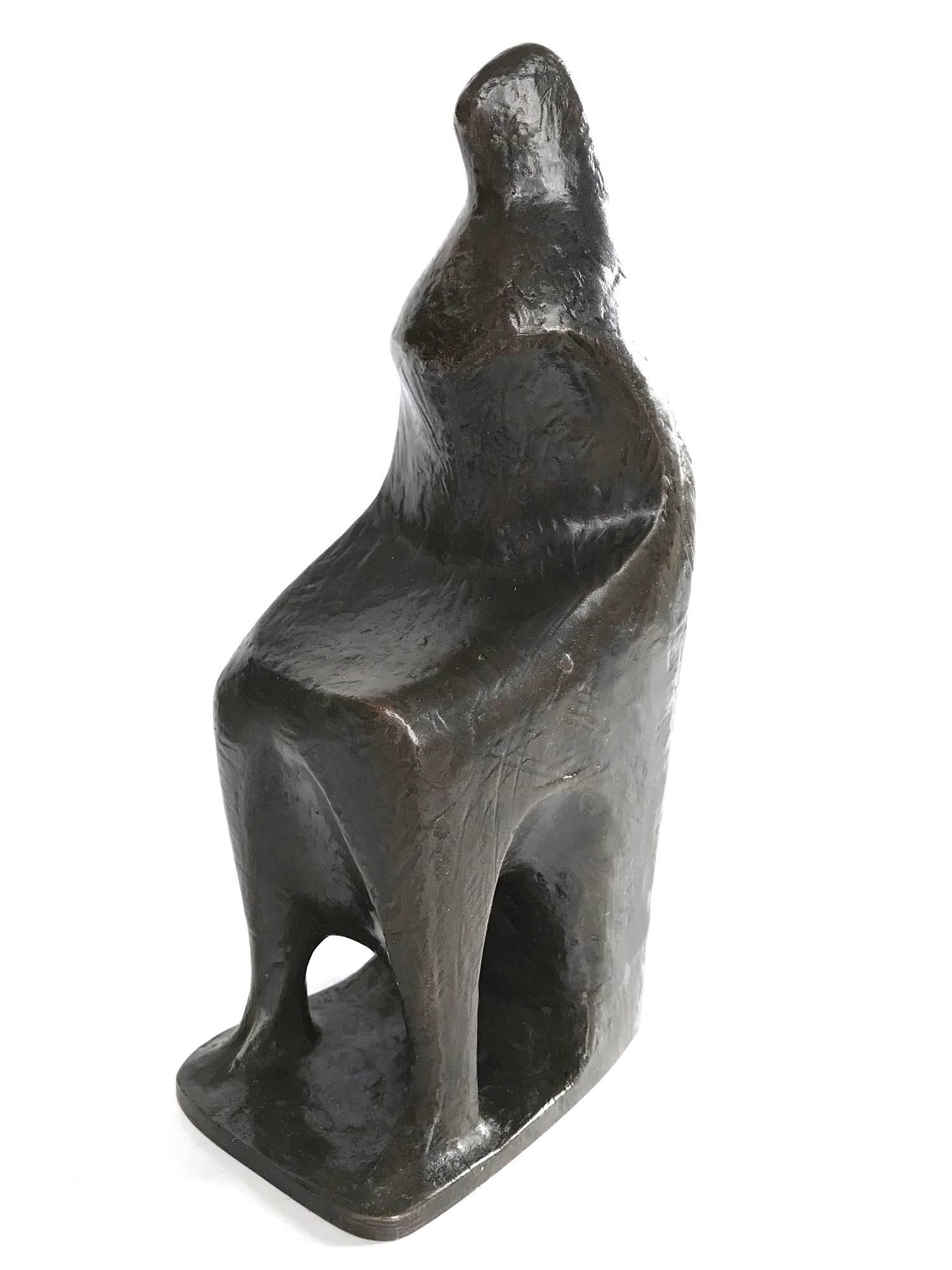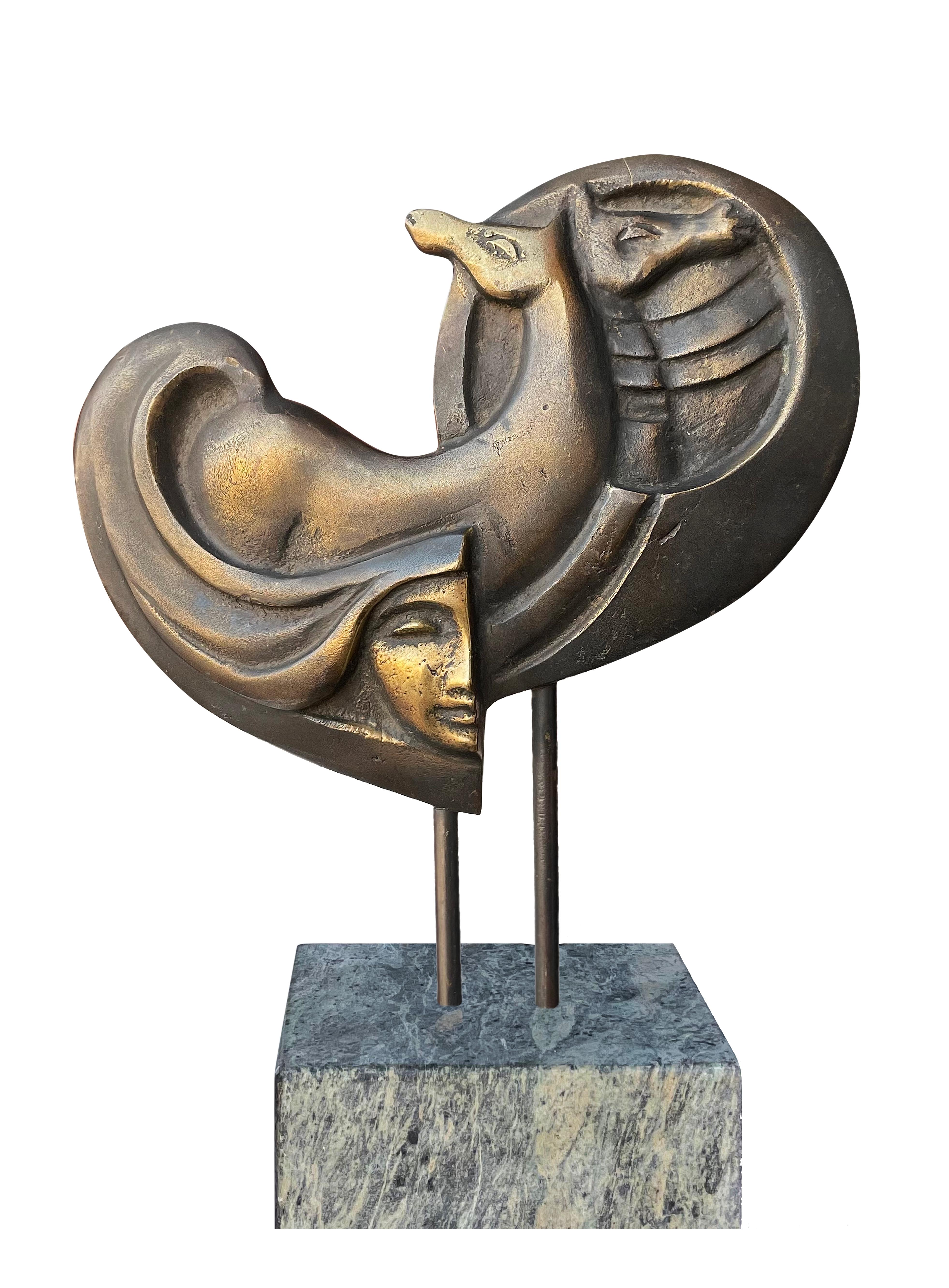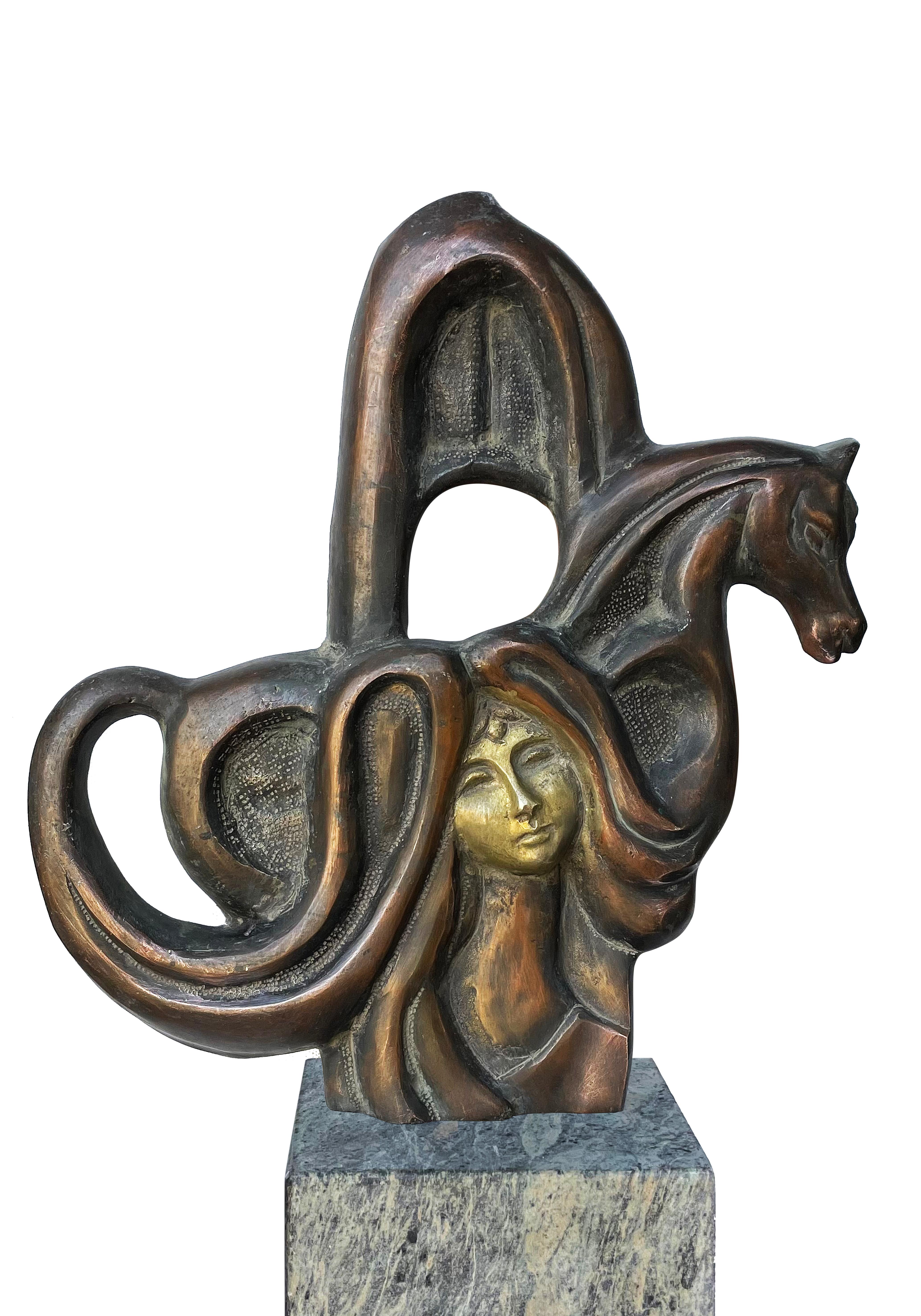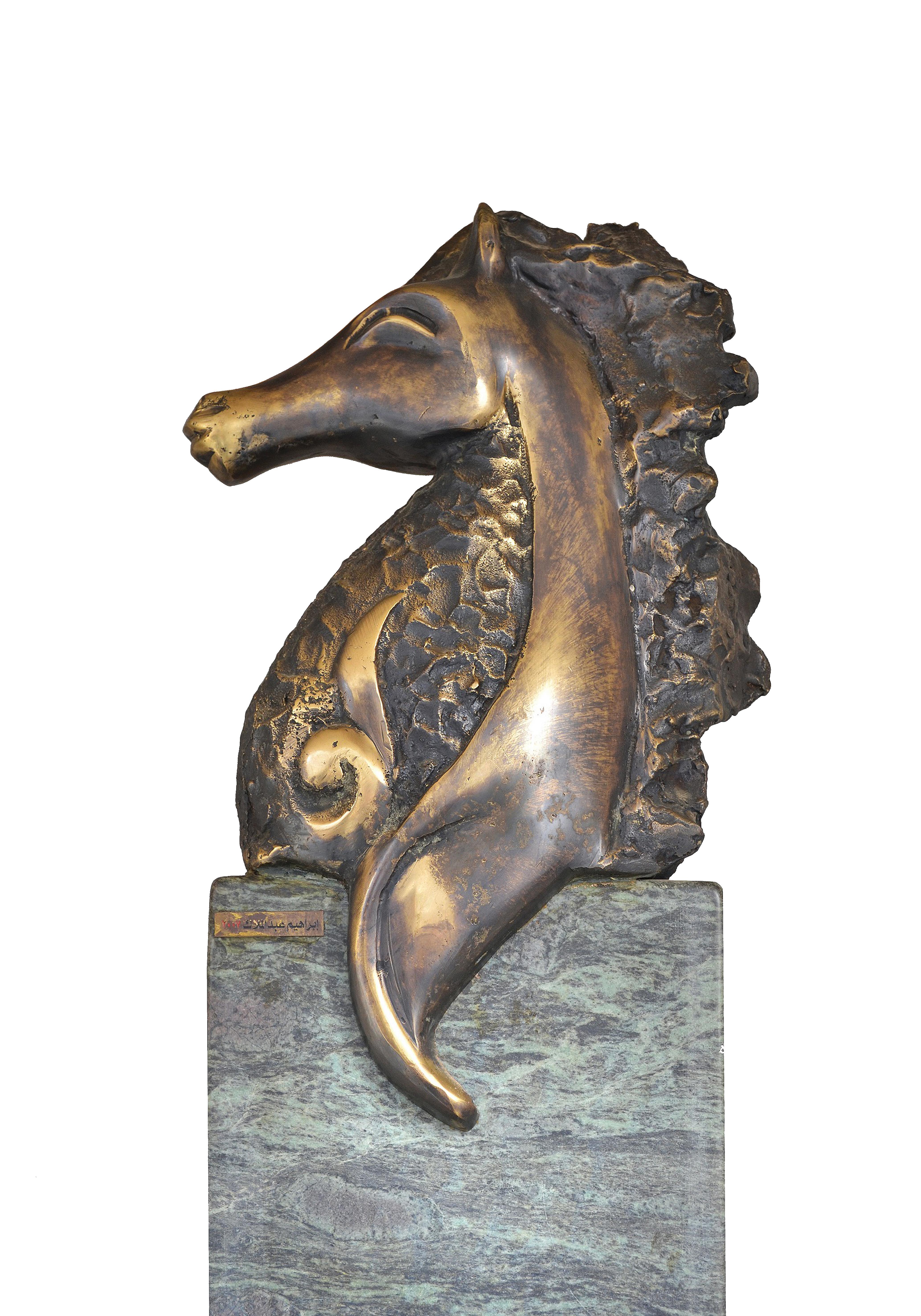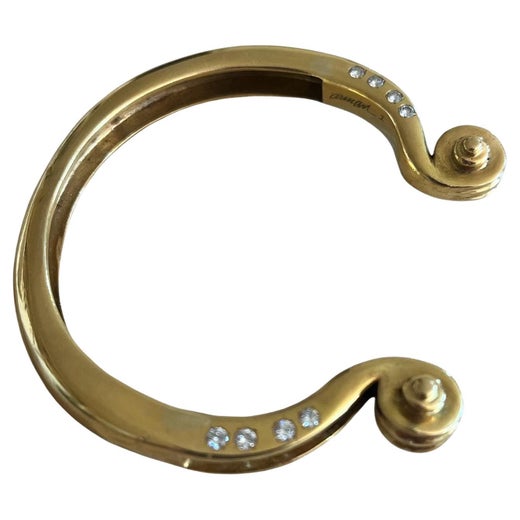Items Similar to French Pop Art Heavy Bronze Sculpture Chess Game Gambit Arman Accumulation
Want more images or videos?
Request additional images or videos from the seller
1 of 7
ArmanFrench Pop Art Heavy Bronze Sculpture Chess Game Gambit Arman Accumulation2003
2003
About the Item
Arman, French American (1928-2005)
Gambit (Chess pieces)
Cast Bronze Sculpture with patina
Incised signature near lower edge, 48/70 with
impressed "Bronze Romain & Fils" foundry mark
Dimensions: (approximate) 17 X 13 X 12 inches
On a flat, square base, Chess pieces are sliced in half and placed in a asymmetrical, cubist manner that allows the viewer to examine the chess pieces from a variety of angles. The cutting also allows the interplay of the colors of the patinas: brown patina for the exterior of the pieces, verdigris patina for the interior of the pieces or bare bronze revealing the artist's cutting technique. Similar to the camera, violin, trumpet and sliced musical instruments that Arman is known for.
Gambit, Sculpture Bronze avec Patine Noire, Signature et Numéro Inscrire.
Arman (November 17, 1928 – October 22, 2005) was a French-born American artist. Born Armand Fernandez in Nice, France, Arman was a painter who moved from using objects for the ink or paint traces they leave ("cachet", "allures d'objet") to using them as the painting itself. He is best known for his "accumulations" and destruction/recomposition of objects. From his father, Arman learned oil painting and photography. After receiving his bachelor's degree in philosophy and mathematics in 1946, Arman began studying at the École Nationale des Arts Décoratifs in Nice. He also started judo at a police school in Nice where he met Yves Klein and Claude Pascal. The trio bonded closely on a subsequent hitch-hiking tour around Europe.
Early on, it was apparent that Arman's concept of the accumulation of vast quantities of the same objects was to remain a significant component of his art. Ironically, he had originally focused more attention on his abstract paintings, considering them to be of more consequence than his early accumulations of stamps. Only when he witnessed viewer reaction to his first accumulation in 1959 did he fully recognize the power of such art. In 1962, he began welding together accumulations of the same kinds of metal objects, such as axes. some of these works were then cast in bronze at Foundry Bocquel, He also made many prints in various techniques including lithograph, silkscreen and etching.
Inspired by an exhibition for the German Dadaist Kurt Schwitters in 1954, Arman began working on "Cachets," his first major artistic undertaking. At his third solo exhibition held in Paris's Galerie Iris Clert in 1958, Arman showed some of his first 2D accumulations he called "cachets." These stamps on paper and fabric proved a success and provided an important change of course for the young artist's career.
At the time, he was signing with his first name as an homage to Van Gogh, who also signed his works with his first name, "Vincent." And, thus, in 1957, Arman chose to change his name from Armand to Arman. On January 31, 1973, upon becoming a citizen of the United States, he took the American civil name, Armand Pierre Arman. Nevertheless, he continued to use "Arman" as his public persona.
In October 1960, Arman, Yves Klein, François Dufrêne, Raymond Hains, Martial Raysse, Daniel Spoerri, Jean Tinguely and Jacques Villeglé, and art critic and philosopher Pierre Restany founded the Nouveau réalisme group. Joined later by Cesar, Mimmo Rotella, Niki de Saint Phalle, and Christo, the group of young artists defined themselves as bearing in common their "new perspective approaches of reality." His work lies at the intersection of Pop art, fluxus and Dada sensibilities with a light dose of cubism. They were reassessing the concept of art and the artist for a 20th-century consumer society by reasserting the humanistic ideals in the face of industrial expansion.
Arman can be seen in the Andy Warhol film Dinner at Daley's, a documentation of a dinner performance by the Fluxus artist Daniel Spoerri that Warhol filmed on March 5, 1964. Throughout the portrait-screen-test film, Arman sits in profile, looking down, appearing to be entranced in his reading, seemingly unaware of Warhol's camera, only making small gestures, rubbing his eyes, and licking the corner of his mouth. He remained silent, eyes gazing over the pages of what seemed to be a newspaper, in this four-minute, 16mm black-and-white reel. Warhol owned two of Arman's Poubelles and another accumulation called Amphetamines, which were sold at Sotheby's auction of the Andy Warhol Collection in May 1988. He is known for his painting and sculpture in particular his assemblage and collage works.
Fascinated with the scene in New York, Arman took up part-time residency there from his home in Nice in 1961, after his first exhibition at the Cordier Warren Gallery. In the city, he met Marcel Duchamp at a dinner given by the artist and collector William Copley.
Arman often adopted destruction as a strategy for creation: He sliced, burned, and smashed objects such as bronze statues and musical instruments, then mounted fragments on canvas, encased them in resin or plexiglass, or presented them alone. In the 1960s, he was associated with Nouveau Réalisme—a European movement founded in response to American Pop art—along with close friend and fellow artist Yves Klein.
Arman exhibited extensively throughout his lifetime and received numerous awards. His work has sold for six figures at auction and belongs in the collections of the Museum of Modern Art, the Hirshhorn Museum and Sculpture Garden, the Tate, the Stedelijk Museum, and the Tel Aviv Museum of Art, among other institutions.
Selected exhibitions and awards
Arman, Stedelijk Museum, Amsterdam, Holland
Arman, Walker Art Center, Minneapolis, Minnesota
Arman, Palazzo Grassi, Venice, Italy
Musée des Arts Decoratifs, Paris, France; *Louisiana Museum of Modern Art Arman, Modern Art Museum, Stockholm, Sweden
Arman, Artcurial auction house, Paris, France
Arman: A Retrospective 1955 - 1991, The Brooklyn Museum, Brooklyn, New York; The Detroit Institute of Art, Detroit, Michigan
Arman, Musée du Jeu de Paume, Paris, France
Arman, Tel Aviv Museum of Art, Israel
Arman: Arman, Museum of Contemporary Art of Teheran, Teheran, Iran
Arman, Marlborough New York City
Arman, a retrospective, Centre Georges Pompidou, Oct. 2010, Paris
Arman, retrospective, Museum Tinguely, Feb. 2011, Basel, Switzerland
Arman-in les Baux de Provence, July-Oct. 2011, Les Baux-de-Provence
Paul Kasmin Gallery, New York
Public collections in the U.S.A., selected
Fine Arts Museums of San Francisco, California
Hirshhorn Museum and Sculpture Garden, Washington, D.C.
Harvard Art Museum, Cambridge, Massachusetts
The Detroit Institute of Arts, Detroit, Michigan
The Museum of Modern Art, New York
- Creator:Arman (1928 - 2005, French)
- Creation Year:2003
- Dimensions:Height: 17 in (43.18 cm)Width: 13 in (33.02 cm)Depth: 12 in (30.48 cm)
- Medium:
- Movement & Style:
- Period:
- Condition:very minor wear. please see photos.
- Gallery Location:Surfside, FL
- Reference Number:1stDibs: LU38214269512
Arman
Arman was born in Nice, France, in 1928, and showed a talent for painting and drawing as a child. He studied at the the Ecole Nationale des Art Décoratifs in Nice followed by studies at the École du Louvre in Paris. In his early years he focused on abstract paintings. Then, in 1957, he became interested in common objects as works of art. He first did what came to be called his "allures d"objet" (object impressions), where he would dip an object into paint and press it on canvas thus leaving the object's shadow or impression. Then he decided the object itself was worth paying attention to and started to treat them in his own way. His intention was to remove the material purpose of an object so that its only remaining function was to "feed the mind" as a work of art. What better way to achieve that result than by breaking, slicing or even burning objects such as violins, telephones, typewriters or even whole cars? He also made objects useless by accumulating them, such as 2,000 wristwatches in a Plexiglass box that all kept different time. Once emotionally detached from the circumstances associated with a broken object, the viewer could grow to appreciate its abstract beauty; so, in a sense, Arman was literally teaching that things one never thought could be regarded as attractive could indeed turn out to be so. Through this achievement, Arman gained worldwide recognition and is regarded as one of the most prolific and inventive creators of the late 20th century. His work can be found in the collections of numerous museums including the Metropolitan Museum of Art in New York, the Tate Gallery in London and the Centre Pompidou in Paris. Arman’s work has also been exhibited in galleries, museums and public spaces worldwide including the Musée D’Art Contemporain in Tehran, Iran; the Museum of Art in Tel Aviv, Israel; the Musée Des Arts Decoratifs and Opéra De Paris in France; the La Jolla Museum of Contemporary Art in California; and the Museum of Arts and Design and the Guggenheim in New York He died in 2005 in New York.
About the Seller
4.9
Platinum Seller
These expertly vetted sellers are 1stDibs' most experienced sellers and are rated highest by our customers.
Established in 1995
1stDibs seller since 2014
1,559 sales on 1stDibs
Typical response time: 1 hour
- ShippingRetrieving quote...Ships From: Surfside, FL
- Return PolicyA return for this item may be initiated within 3 days of delivery.
More From This SellerView All
- Bronze Sculpture Abstract Brutalist Goat or Ram WPA Artist Mounted on BaseBy Benedict Michael TattiLocated in Surfside, FLBenedict Tatti (1917-1993) worked in New York city as a sculptor, painter, educator, and video artist. He studied stone and wood carving under Louis Slobodkin at the Roerich Museum. He later attended the Leonardo da Vinci School of Art studying under Attilio Piccirelli. In l939 he taught adult classes with the Teachers Project of the WPA and attended the Art Students League for three and a half years on full scholarship. He studied under William Zorach and Ossip Zadkine and later became Zorach’s assistant. Later in his career, he attended the Hans Hofmann School of Fine Arts. During World War II, Tatti served in the United States Army Air Force, where he spent three years assigned to variety of projects. In 1948, Benedict Tatti married Adele Rosenberg in New York City. Throughout his career, Tatti continuously experimented with various media. From 1952-1963, Tatti executed sculptural models of architectural and consumer products for the industrial designers, Raymond Loewy Associates; later he became a color consultant for the firm. In the 1960s, influenced by the Abstract Expressionists, Tatti turned from carving directly in wood and stone to creating assemblage architecture sculptures, using bronze metal and other industrial materials. He was included in the important show "Aspects de la Sculpture Americaine", at Galerie Claude Bernard Paris, France, in October 1960 along with Ibram Lassaw, Theodore Roszak, David Smith, Louise Bourgeois, Danese Corey, Dorothy Dehner, Lin Emery...Category
Mid-20th Century Abstract Expressionist Abstract Sculptures
MaterialsBronze
- Karel Appel Colorful Expressionist Hand Painted Wood Cobra Sculpture Pop ArtBy Karel AppelLocated in Surfside, FLThis is an original wooden sculpture with hand painting on both sides. it does not appear to be signed or numbered and does not currently have any label. I believe this might be the proof, There was an edition of these and this is a unique variant. All done by hand. It is on a base and revolves and rotates easily as there are ball bearings. It is very well made. Christiaan Karel Appel (1921-2006) was a Dutch artist, painter, sculptor, and poet. Born in Amsterdam, the Netherlands, he died in Zurich, Switzerland. He started painting at the age of fourteen and studied at the Rijksakademie in Amsterdam in the 1940s. He was one of the founders of the avant-garde movement Cobra in 1948. He was also an avid sculptor and has had works featured in MoMA, the Stedelijk and other museums worldwide. At fourteen, Appel produced his first real painting on canvas, a still life of a fruit basket. For his fifteenth birthday, his wealthy uncle Karel Chevalier gave him a paint set and an easel. An avid amateur painter himself, Chevalier gave his namesake some lessons in painting. From 1940 to 1943, during the German occupation, Appel studied at the Rijksakademie van Beeldende Kunsten in Amsterdam, and it was there he met the young painter Guillaume Corneille and, some years later, Constant; they became close friends for years. Appel had his first show in Groningen in 1946. In 1949 he participated with the other CoBrA artists in the Stedelijk Museum Amsterdam; this generated a huge scandal and many objections in the press and public. He was influenced by Pablo Picasso, Henri Matisse, and the French brute-art artist Jean Dubuffet. In 1947 he started sculpting with all kinds of used materials (in the technique of assemblage) and painted them in bright colors: white, red, yellow, blue, and black. He joined the Experimentele Groep in Holland together with the young Dutch painters Anton Rooskens...Category
1970s Abstract Expressionist Abstract Sculptures
MaterialsWood, Paint
- Rachid Khimoune French Algerian Arab Art Brut Bronze Sculpture Abstract FigureLocated in Surfside, FLRachid Khimoune (Algerian, b. 1953) Les enfants du monde bronze. signed and numbered artist's edition of 4 foundry mark - L. Cappe 7.5 x 4.63 x 2.38 Overall: 8.25 x 4.63 x 2.38 RACHID KHIMOUNE, Algerian-French artist and sculptor. Born in 1953 in Decazeville, France. Lives and works in Paris, France. Rachid Khimoune graduated from the School of Art of Paris in 1974; he initially started to work with painting before choosing sculpture. In 1980 he won the first prize of the Foundation of France. He works in an Art Brut, Naif art style similar to Jean Dubuffet and Enrico Baj. Being the recipient of numerous prestigious awards and an extensive oeuvre, Rachid Khimoune has been exhibiting since 1975 and his work can be found in several museums, and public and private collections. The artist behind the project Rachid Khimoune, has been responsible for a number of major, successful public art installations in France. Most famously, the installation close to the Bibliothèque Nationale (National Library) ‘Les Enfants du Monde’ (The Children of the World). Rachid’s newer works are masks and totems cast in bronze: poetic images forged in a furnace. Rachid uses discarded objects and disused parts of machines, to create new human and animal forms. Here his interest in metal-working and Arab art-African art coincides with the assemblage of found objects; one mask is a collage constituted by a large model of the Eiffel Tower stuck into the end of a trumpet. Another has a jerry-can for a face, and the golden patina and surface-working of the bronze does not dispel the idea which this image creates: of a human mouth drinking oil. Born in France to parents from Algeria, Khimoune embraces the role of the artist as a global citizen, using art as a universal language. Select Awards Lauréat du Prix de la Fondation de France (1980) Chevalier des Arts et Lettres (2002) Grande Médaille de la Ville de Paris (2004) Chevalier de la Légion d’Honneur (2007) EXHIBITIONS SOLO EXHIBITIONS 2017 Ar[T]senal, Dreux, France 2016 Musée Tavet Delacour, Pontoise, France 2015 Parvis de l’Hotel de ville, Paris 2015 Beirut Art Fair, Beyrouth, Liban 2015 Galerie Francoise Souchaud, Lyon 2014 Musée Rabelais, Seuilly, France 2013 Galerie Vallois...Category
20th Century Expressionist Abstract Sculptures
MaterialsBronze
- Israeli Bronze Sculpture Lovers Embrace Abstract Modernist Ein Hod IsraelBy Gedalia Ben ZviLocated in Surfside, FLBronze sculpture signed in Hebrew and numbered from small edition of 6 BIOGRAPHY "I was born in Czechoslovakia in the year 1925, of traditional parents. I spent my youth partly in a little town on the Moravian border, and to a greater part in Bratislava, the capital of Slovakia. Having been attracted by the arts from early childhood on, I studied functional art at a school in Bratislava, as long as this was still possible under the Nuremberg Laws which, at that time, were also in force in Slovakia. In 1942 I was taken to a concentration camp in Poland and at the beginning of 1945 I succeeded in escaping together with a friend of mine. Until our liberation by the Russians we were hiding in the forests of Northern Poland. At the end of the War I found myself wandering about Europe, together with thousands of survivors from the Holocaust, until, in 1948 I came to Israel via the Camps of Cyprus. From 1954 onwards I have been a permanent resident of the Artists Village at Ein-Hod, together with my family. In the course of that time I studied and worked in most of the creative techniques of the arts. During various periods of my life at Ein-Hod I taught painting and handicraft at different schools. In 1965 I gave up teaching and have since devoted myself exclusively to pure art." Gedalia Ben Zvi. Exhibitions 1962-1963 Design Exhibition, Tel Aviv 1964 Middle East Fair, Tel Aviv 1965 Ceramic Mural for school in Kiryat Gat a the Housing Exhibition in Tel Aviv 1966 Israel Fair and Exhibition, Paris One man show, Ein Hod International Symposium on “Ceramics in Architecture” Tel Aviv Ceramic Museum Museum or Modern Arts, Heavy Museum of Acre 1968 Painters Israeliens dans I’Art de Gobelins, Jerusalem Ein Hod Artists Village - Tenths Year Anniversary Exhibition 1963, Artists: Zvi Aldouby, Marcel Janco, Rudi Lehmann, Moshe Mokady, Aviva Margalit Mambush, Yohanan Simon, Dov Feigin, Ovadia Alkara, Mark Tochilkin...Category
Mid-20th Century Modern Figurative Sculptures
MaterialsBronze
- Mexican Art Abstract Brutalist Biomorphic Bronze Sculpture Mathias GoeritzBy Mathias GoeritzLocated in Surfside, FLMathias Goeritz (German Mexican, 1915-1990) Bronze sculpture Signed and numbered Dimensions: (approximate) Height: 10 inches, Width: 4 inches, Depth: 2 inches. This is a cast bronze sculpture in an amorphous figure shape, quite heavy. Reminiscent of the biomorphic sculpture of Hans Jean Arp. This came from an estate and bears his signature It is not dated. there is no accompanying documentation. it is priced accordingly. Werner Mathias Goeritz Brunner (Danzig, Germany, April 4th, 1915/ now Gdansk, Poland – Mexico City, Mexico; August 4th, 1990). Mathias Goeritz has had several gallery and museum exhibitions, including at the Museo Nacional Centro de Arte Reina Sofía and at the Museo Experimental El Eco. Numerous works by the artist have been sold at auction, including 'MENSAJE' sold at Sotheby's New York 'Latin American Modern Art' in 2015 for $466,000. There have been Several articles about Mathias Goeritz, including 'LACMA remaps Latin America' written by Suzanne Muchnic for the Los Angeles Times. Painter, sculptor and Mexican architect associated with the trend of constructive abstraction. He studied medicine at the University of Berlin, but this only lasted a year. The concerns of the young student were aesthetic in nature so he he studied figurative drawing at the Berlin Charlottenburg School of Art. Some of his friends and colleagues were the sculptor Ernst Barlach, painter George Grosz and draughtsman Kaethe Kollwitz. Goeritz studied philosophy and history of art, discipline in which earned a doctorate. He travelled in France, Switzerland, Czechoslovakia, Poland, Austria and Italy, among other countries. It is known that he left Germany to live in Tetuan, Morocco in 1941 and then Granada, Spain in 1945. In 1946 he had a large exhibition in the Sala Clan in Madrid under the pseudonym "Mago". Two years later, living in Santilla del Mar, Spain he was a founder of the Escuela de Altamira. The following year he married Marianne Gast, writer and his companion for more than fifteen years. In Spain followed his artistic work by important artists of the avant-garde. Of Jewish descent, he found refuge from the Second World War in Mexico where in 1949 he was invited by Ignacio Diaz Morales to be a part of the faculty of the School of Architecture at the Universidad de Jalisco. In 1953 he wrote the "Manifiesto de la Arquitectura Emocional" (The Emotional Architecture Manifesto), where he points out that only achieving true emotions from architecture can it then be considered an art form. In Mexico he entered controversy with the artistic stablishment of that country; in an open letter, Diego Rivera and David Alfaro Siqueiros described him as "an impostor without the most insignificant talent and preparation" to be an artist. Despite this, in 1957 he was elected director of visual design of the National School of architecture This same year he founded the Museo del Eco in Mexico City. In 1961 Goeritz participated at the Galería Antonio Souza in a group exhibition, Los hartos, for which he published another manifesto. Other participants included Jose Luis Cuevas and Pedro Friedeberg, with whom he was instrumental in establishing abstraction and other modern trends in Mexico.His work is included in the Gelman Collection of modern and contemporary Mexican art based in Cuernavaca, Mexico. Established by Jacques and Natasha Gelman in 1943 as a private collection. it includes many iconic works by major Mexican Modernists including Frida Kahlo, Diego Rivera, David Alfaro Siqueiros, Leonora Carrington, Rufino Tamayo and Francisco Toledo, Lola Alvarez...Category
20th Century Modern Abstract Sculptures
MaterialsBronze
- Large Aharon Bezalel Israeli Modernist Bronze Brutalist Puzzle Sculpture FiguresBy Aharon BezalelLocated in Surfside, FLAharon Bezalel (Afghani-Israeli, 1925-2012) Family Grouping Hand signed in with initials in English Figures fit together like puzzle pieces in solid cast bronze with original patina. Aharon Bezalel (born Afghanistan 1926) Born in Herat, Afghanistan in 1926 and immigrated to Israel at an early age. His father, Reuven Bezalel, was a rabbi and kabbalist. As a youth Aharon studied gold and silver casting as well as applied arts and worked in these fields as a silversmith and judaica craftsman, and was a student of the sculptor Zev Ben-Zvi at the Bezalel Academy for Art & Design where he also studied with Isidor Ascheim and Mordecai Ardon. There he absorbed the basic concepts of classic and modernist art and interpreted, according to them, ideas based on ancient Hebrew sources. He also studied miniature carving with the artists Martin and Helga Rost applying himself at their workshop. Aharon Bezalel worked and resided in Jerusalem, he taught art for many years. His sculptures - works of wood, bronze, aluminum, Plexiglas - were shown at his studio in Ein Kerem. “I saw myself as part of this region. I wanted to find the contact between my art and my surroundings. Those were the first years of Jean Piro’s excavations at the Beer-Sheba mound. They found there, for example, the Canaanite figurines that I especially liked and that were an element that connected me with the past and with this place.” “…a seed and sperm or male and female. These continue life. The singular, the individual alone, cannot exist; I learned this from my father who dabbled with the Kabbalah.” (Aharon Bezalel, excerpt from an interview with David Gerstein) “The singular in Aharon Bezalel’s work is always potentially a couple if not a threesome, the one is also the many: when the individual is revealed within the group he will always seek a huddling, a clinging together. The principle of modular construction is required by this perception of unity and multiplicity, as modular construction in his work is an act of conception or defense. His work bears a similarity to Berrocal as well as affinities to Henry Moore, Lynne Chadwick and Kenneth Armitage. Two poles of unity, potentially alone, exist in A. Bezalel’s world: From a formal, sculptural sense these are the sphere and pillar, metaphorically these are the female in the final stages of pregnancy and the solitary male individual. Sphere-seed-woman; Pillar-strand-man. The disproportional, small heads in A. Bezalel figures leave humankind in it’s primal physical capacity. The woman as a pregnancy or hips, the man as an aggressive or defensive force, the elongated chest serves as a phallus and weapon simultaneously. (Gideon Ofrat) EIN HAROD About the Museum's Holdings: Israeli art is represented by the works of Reuven Rubin, Zaritzky, Nahum Gutman...Category
Mid-20th Century Expressionist Abstract Sculptures
MaterialsBronze
You May Also Like
- Golden "Taurus" sculpture, made from bronze, by Gianfranco MeggiatoBy Gianfranco MeggiatoLocated in Palm Beach, FLKinetic Bronze sculpture Size US: 40 1/5 × 13 4/5 × 13 4/5 in Size Europe: 102 × 35 × 35 cm Edition 1/6Category
2010s Abstract Abstract Sculptures
MaterialsBronze
- "Seated Figure Looking Up" Modern Mid Century BronzeBy Joachim BertholdLocated in New York, NYA beautiful modernist 20th Century Bronze piece by Joachim Berthold. Here we find this stylish figure sitting in a hoping position looking up that eludes thought and complexity. A me...Category
2010s Abstract Expressionist Figurative Sculptures
MaterialsBronze
- "Love of Horses" Bronze and Marble sculpture 16" x 7" in by Ibrahim Abd ElmalakLocated in Culver City, CA"Love of Horses" Bronze and Marble sculpture 16" x 7" in by Ibrahim Abd Elmalak Love of Horses, 2000 Bronze & Marble (Double Face) 40 x 18 cm, Signed & Dated Sculptures that mostl...Category
21st Century and Contemporary Abstract Expressionist Figurative Sculptures
MaterialsMarble, Bronze
- "Entropy" Bronze sculpture 22" x 9" inch by Ibrahim Abd ElmalakLocated in Culver City, CA"Entropy" Bronze sculpture 22" x 9" inch by Ibrahim Abd Elmalak Entropy, 2005 Bronze & Marble Signed & Dated Sculptures that mostly depict his ...Category
21st Century and Contemporary Abstract Expressionist Figurative Sculptures
MaterialsMarble, Bronze
- "Equine Spirit II" Bronze sculpture 23" x 14.5" inch by Ibrahim Abd ElmalakLocated in Culver City, CA"Equine Spirit II" Bronze sculpture 23" x 14.5" inch by Ibrahim Abd Elmalak Equine Spirit II, 1997 Bronze & Marble Signed & Dated Sculptures that mostly depict his characteristic...Category
20th Century Abstract Expressionist Figurative Sculptures
MaterialsMarble, Bronze
- "Grecian Stallion I" Bronze sculpture 24" x 11" inch by Ibrahim Abd ElmalakLocated in Culver City, CA"Grecian Stallion I" Bronze sculpture 24" x 11" inch by Ibrahim Abd Elmalak Grecian Stallion I, 2007 Bronze & Marble Signed & Dated Sculptures that mostly depict his characterist...Category
21st Century and Contemporary Abstract Expressionist Figurative Sculptures
MaterialsMarble, Bronze
Recently Viewed
View AllMore Ways To Browse
Heavy French
Paris Art Bronze
Heavy Sculpture
Nice France Art
70s French Art
Small French Sculpture
Asymmetric Art
Sculpture In Art Nouveau
Sculpture Two Faces
Bronze Face Sculpture
Mouth Sculpture
Bronze Garden Sculpture
French Art Nouveau Sculpture
Bronze Angle
Sculpture Entrance
Small Bronze Modern Sculpture
1960s Modern Figurative Sculpture
Square Light Sculpture

